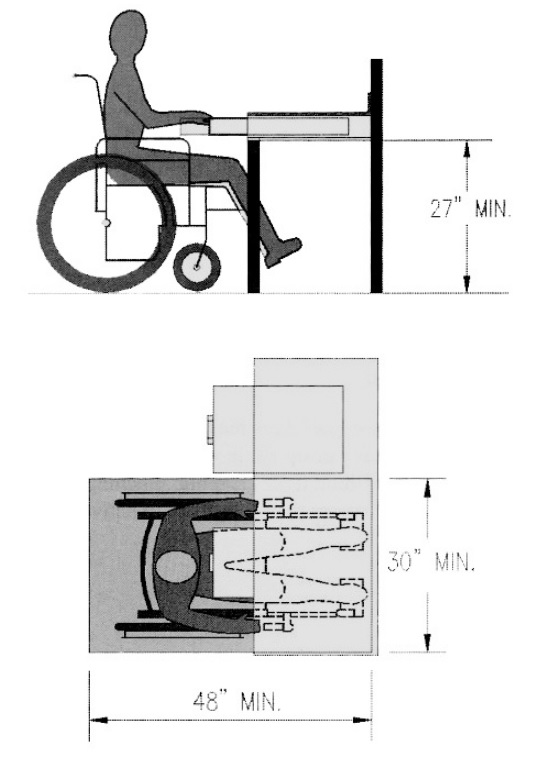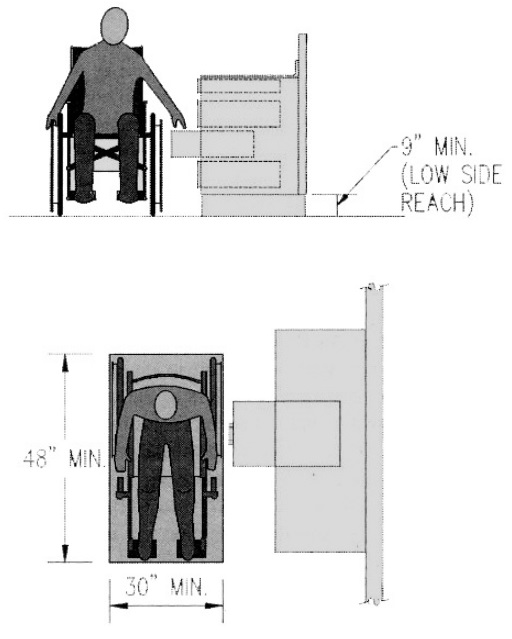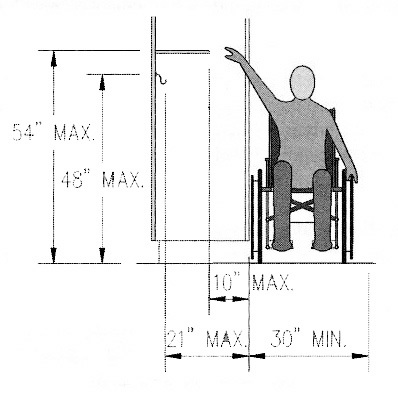Storage [4.25]
Scoping [4.1.3(12)]
ADAAG covers fixed or built-in storage facilities in public or common use spaces and requires access to at least one of "each type." "Type" refers to the design of the element (shelving, cabinets, closets) as well as the intended use (coat closets, supply closets). Additional storage elements of the same type are not required to comply; for example, if above-counter cabinets are provided, only the lowest shelf of one such wall cabinet need be accessible. Shelves and display units allowing self-service by customers in mercantile occupancies are not required to comply with this section but are required to be on an accessible route. However, at least half of all self-service shelves in restaurant and cafeteria food service lines are required to be accessible in ADAAG 5.5.
Work Areas
Storage facilities used by employees for purposes other than job-related tasks, such as break room cabinets and shower room lockers, are required to be accessible. Those used only by employees at a work station (janitor closets) or as part of a work area (stockroom shelves) are not required to comply (although work areas must be on an accessible route for approach, entry, and exit as required in 4.1.1(3)). Recommendation: Accessible or adaptable storage facilities however may be advisable in facilitating accommodation of employees with disabilities.
Lockers
Lockers, although not specifically referenced, are a type of storage facility required to be accessible in public or common use facilities. Recommendation:In health clubs and gyms where a large number may be provided, consider a minimum of 5% instead of "at least one" of each type. Where only a limited number of lockers are accessible, identifying those that are accessible with the access symbol is helpful.
Self-Service Storage Facilities
Self-service storage facilities are not specifically addressed by ADAAG but where they are provided for rent by the public, access must be provided. Recommendation: Access to at least 5% of each type is recommended.
Clear Floor Space [4.25.2] and Height [4.25.3]
Clear floor space for either a forward or side approach is allowed. However, since people who use wheelchairs may not be able to reach beyond the toes, a forward reach is generally limited to those storage elements providing knee and toe clearances. Otherwise, space must be provided for a side approach.


A side reach is necessary at cabinets, lockers, and shallow closets. Space for a side approach is also helpful since the side reach is higher and lower than the forward reach. ADAAG specifies maximum reach heights according to the depth of reach.

Hardware [4.25.4]
Hardware should be exposed (as required for sliding doors in 4.13) and must:
-
be automatic or operable with one hand
-
operate without tight grasping, pinching, or twisting of the wrist
-
require no more than 5 lb force to activate

User Comments/Questions
Add Comment/Question